Social Studies 4
Grade 4
Construct arguments defending the significance of individuals/groups, places, events, or developments (significance):
Key questions:
- What events are most significant in the story of BC’s development
- History of BC (comprehensive article with timeline)
- “Far West” is a History of BC for young readers
- “Far West” timeline
- Search for any event in BC history, eg.
- Fur trade, Chapter 2 of “Far West”, on Arrival of the Traders
- Land Based Fur Trade
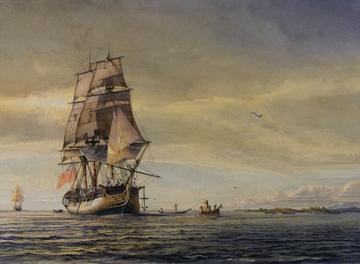
This painting shows Captain James Cook in his vessel Resolution entering Nootka Sound in 1778. Gordon Miller painting
- Should James Douglas be remembered as the father of BC?
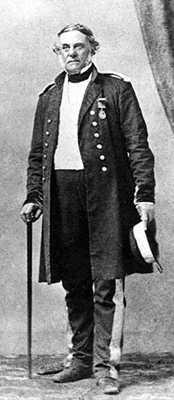
James Douglas, first governor of the colony of BC, 1858–64. BC Archives HP-2652
- What was the most significant reason for BC’s entry into Confederation?
- Confederation
- Confederation League
- Chapter 4 of Far West, on Joining Canada
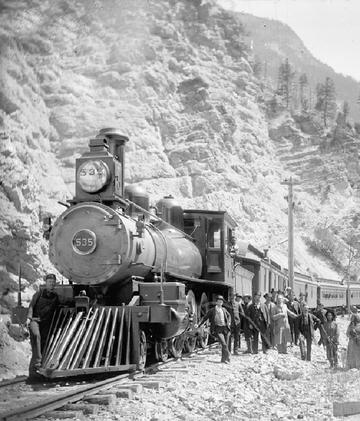
The Canadian Pacific Railway, completed in 1885, connected British Columbia to the rest of Canada beyond the mountains. City of Vancouver Archives. CAN-P.218, N.224
Sequence objects, images, or events, and determine continuities and changes between different time periods or places (continuity and change):
|
Sample activity:
|
Key questions:
- How have the economic centres of BC changed over time?
- Economy of BC
- Chapter 5 of Far West, Resources and the Economy
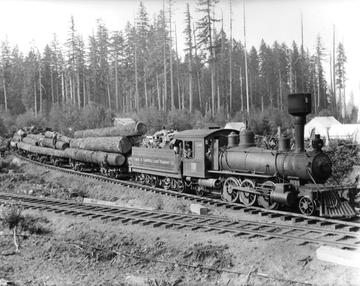
Above: One of the many steam engines that transported logs out of the woods, along special railways and right to the sawmills. The picture was taken in 1909, near Courtenay on Vancouver Island. Vancouver Public Library 6044
- Search for:
- A community name, eg.
- Kitimat
- An industry, eg.
- Pulp and Paper
- Why is Barkerville no longer a significant economic centre?
- Barkerville, Historic Town
- Chapter 3 of Far West, on Gold Rush
- Billy Barker

Miners at the Mucho Oro gold mine near Barkerville, 1868. Frederick Dally/UBC BC389
- What resources are important to people in present-day BC compared to people in the past? Explain what has changed over time.
- Resources and the Economy (for historical resources)
- Economy of BC
- High-Tech Industries
- Biotechnology
- Subsea Technology
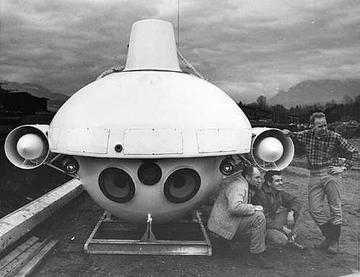
The inventors of the Pisces submersible (l to r): Don Sorte, Mack Thompson, Al Trice, 1965.
- Search for a resource, eg:
- Gold
- Gold Rush
- Logging, Working in the Woods
- Saving the Forests
Differentiate between intended and unintended consequences of events, decisions, or developments, and speculate about alternative outcomes (cause and consequence):
|
Sample activities:
|
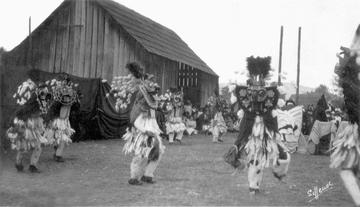
Key questions:
- Was joining Canada the best decision for BC?
- Why did Vancouver become BC’s largest city?
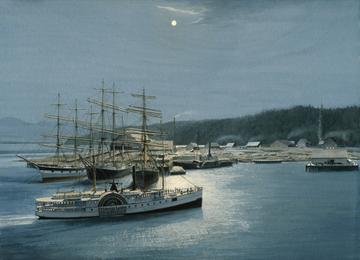
The Beaver, by then a coastal workboat, at Gastown in 1885. In a year’s time the sleepy sawmill village would become the City of Vancouver and be transformed by the arrival of the Canadian Pacific Railway. Gordon Miller painting
Construct narratives that capture the attitudes, values, and worldviews commonly held by people at different times or places (perspective):
|
Sample activity:
|
Key question:
- Who benefited most from the early west coast fur trade: First Peoples or Europeans?
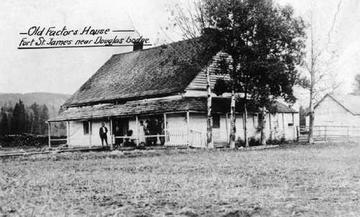
Old fur trade factor's house, Fort St James.
Make ethical judgments about events, decisions, or actions that consider the conditions of a particular time and place (ethical judgment):
|
Sample activities:
|
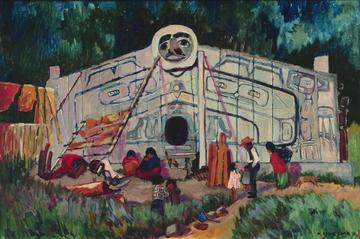
This painting by Emily Carr, completed in about 1912, is called House Front—Gold Harbour. It shows one of the cedar plank houses built by the First Nations people. Vancouver Art Gallery
Early contact, trade, co-operation, and conflict between First Peoples and European peoples:
Sample topics:
- Early explorers: Cabot, Frobisher, Hudson, Cartier, Champlain
- Search for explorers to BC, eg.
- Fraser
- Mackenzie
- Grease Trails
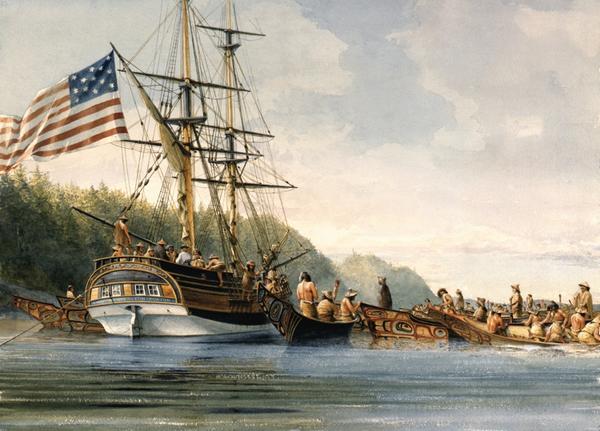
Lady Washington was one of the ships belonging to the American sea-otter traders. It is shown trading at Ninstints, a village in the Queen Charlotte Islands, in 1791. Gordon Miller painting
- Voyages of Cook and Vancouver
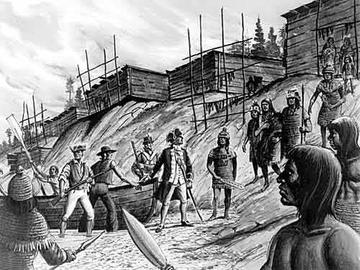
Captain Cook's Arrival in Nootka Sound, 1778, an illustration by Robert John Banks, 1970. BC Archives PDP-00494
- Provision of muskets to First Peoples by Europeans
- Spread of horses to the Prairies
- Marriages between First Peoples and Europeans
- Colonial wars and alliances between Europeans and First Peoples (e.g., between Maquinna [Nuu chah-nulth] and the Cook expedition or between French colonists and the First Peoples living around the Great Lakes)
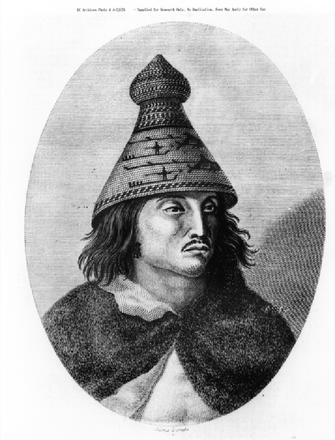
Chief Maquinna of Yuquot. The hat he is wearing shows scenes from a whale hunt. It was made from cedar bark and spruce roots. Only chiefs were allowed to wear the whaling hat. BC Archives A-02678
Key questions:
- What motivated explorers and settlers to come to Canada?
- How did the geography of Canada affect European exploration?
- Chapter 2 of Far West, on Arrival of the Traders
- Physical Geography of BC
The fur trade in pre-Confederation Canada and British Columbia:
Sample topics:
- Fur trading companies (e.g., the Hudson’s Bay Company and the North West Company)
- Hudsons Bay Company
- Chapter 2 of Far West, Hudson Bay Company
- North West Company
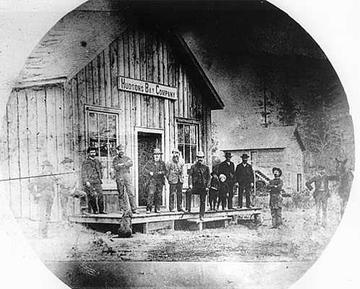
The first Hudson's Bay Co store at Vernon, built in 1887. BC Archives H-00250
- Beaver Wars
- explorers:
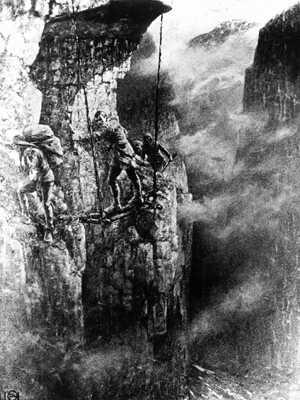
Aboriginal guides lead Simon Fraser and his crew along the precipitous cliffs of the Fraser Canyon, as shown in a painting by John Innes. VPL 13315
- Russian and Spanish trade on the coast
- Establishment of trading posts (e.g., Victoria, Fort Langley, and other forts; Metis communities)
- Search for name of trading post, eg.
- Fort Langley
- Fort Victoria
- Land Based Fur Trade
- Fur Trade in New Caledonia
- Metis
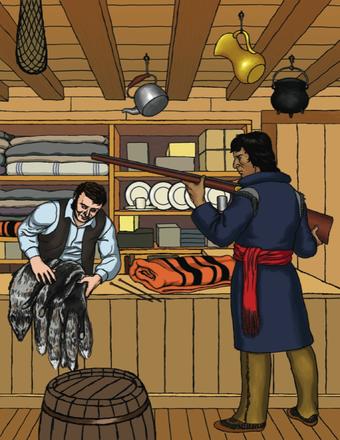
Most of the men who worked for the North West Company were French- Canadian voyageurs. Or they were Métis (MAY- tee), a mix of French and Aboriginal. For this reason the working language of the fur trade in British Columbia at this time was French.
Demographic changes in pre-Confederation British Columbia in both First Peoples and non–First Peoples communities:
Sample topics:
- Disease
- Search for disease name, eg.
- Smallpox
- Disease
- Aboriginal Demography
- European and American settlement and migration
- First European
- History of BC
- Chapter 2 of Far West, on Arrival of the Traders
- Chapter 2 of Far West, Creating a Colony
- Relocation/resettlement of First Peoples
- Example of voluntary resettlement Blunden Harbour
- Reserveshttp://knowbc.com/books/Encyclopedia-of-BC/R/Reserves
- First Nations of BC
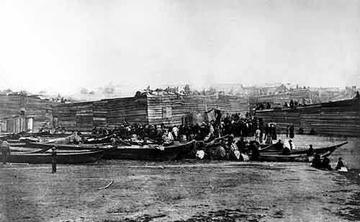
Coast Salish potlatch in the Fraser Valley.
Economic and political factors that influenced the colonization of British Columbia and its entry into Confederation:
Sample topics:
- Canadian Pacific Railway
- Canadian Pacific Railway
- Chapter 4 of Far West, Building the Railway

A Chinese work gang takes a rest from the backbreaking labour of building the railway, 1880s. Glenbow Archives NA3740-29
- American settlement
- Oregon Boundary Dispute
- Gold rush population boom and bust
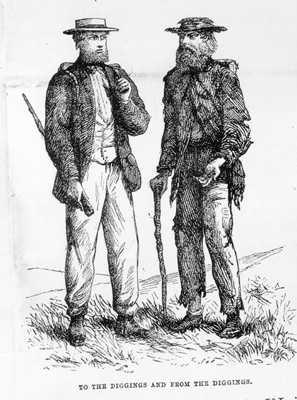
Engraving from the 1860s depicting the typical gold prospector, before and after. UBC BC439
- Colonial debt
- Chapter 4 of Far West, Canadian Confederation
- Expansion and purchase of Rupert’s Land
The impact of colonization on First Peoples societies in British Columbia and Canada:
Sample topics:
- Disease and demographics
- Aboriginal Demography
- Chapter 4 of Far West, Disease
- Search for disease name, eg.
- Smallpox
- Influenza
- More complex political systems
- Loss of territory
- Impact on language and culture
- Key events and issues regarding First Peoples rights and interactions with early governments in Canada (e.g., the Indian Act, potlatch ban, reserve system, residential schools, treaties)

Fish weir, c 1860. Weirs were used on the Cowichan R by aboriginal fishers until the 1930s. BC Archives H-06525
The history of the local community and of local First Peoples communities:
- Search for:
- Local community name, eg.
- Duncan
- Local First Peoples community name, eg.
- Cowichan First Nation
- Salishan First Nations
- An event, eg.
- Trail Smelter opening
- A person, eg.
- Heinze, owner of Cominco mines at that time
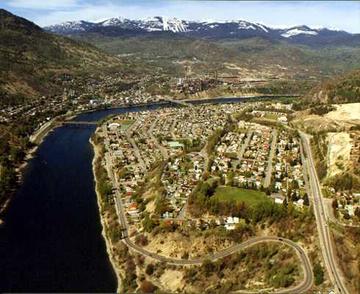
Aerial view of Trail, 1999. Larry Doell photo
